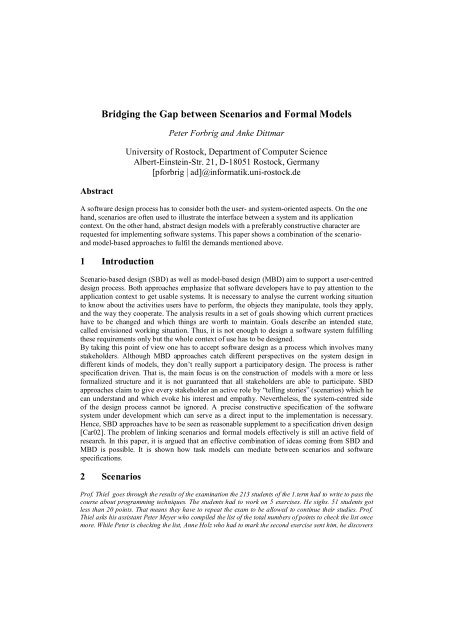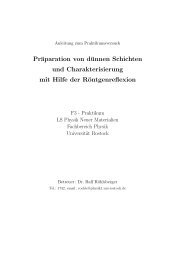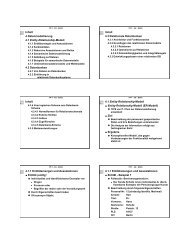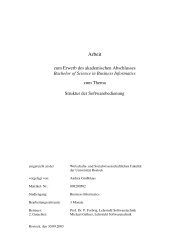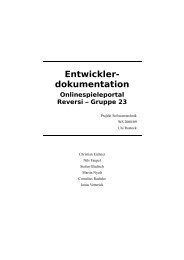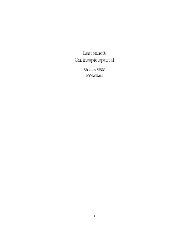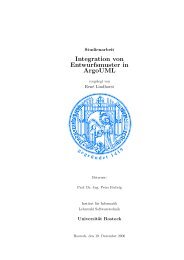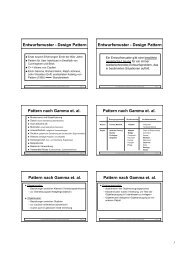paper - Universität Rostock
paper - Universität Rostock
paper - Universität Rostock
You also want an ePaper? Increase the reach of your titles
YUMPU automatically turns print PDFs into web optimized ePapers that Google loves.
Abstract<br />
Bridging the Gap between Scenarios and Formal Models<br />
Peter Forbrig and Anke Dittmar<br />
University of <strong>Rostock</strong>, Department of Computer Science<br />
Albert-Einstein-Str. 21, D-18051 <strong>Rostock</strong>, Germany<br />
[pforbrig | ad]@informatik.uni-rostock.de<br />
A software design process has to consider both the user- and system-oriented aspects. On the one<br />
hand, scenarios are often used to illustrate the interface between a system and its application<br />
context. On the other hand, abstract design models with a preferably constructive character are<br />
requested for implementing software systems. This <strong>paper</strong> shows a combination of the scenarioand<br />
model-based approaches to fulfil the demands mentioned above.<br />
1 Introduction<br />
Scenario-based design (SBD) as well as model-based design (MBD) aim to support a user-centred<br />
design process. Both approaches emphasize that software developers have to pay attention to the<br />
application context to get usable systems. It is necessary to analyse the current working situation<br />
to know about the activities users have to perform, the objects they manipulate, tools they apply,<br />
and the way they cooperate. The analysis results in a set of goals showing which current practices<br />
have to be changed and which things are worth to maintain. Goals describe an intended state,<br />
called envisioned working situation. Thus, it is not enough to design a software system fulfilling<br />
these requirements only but the whole context of use has to be designed.<br />
By taking this point of view one has to accept software design as a process which involves many<br />
stakeholders. Although MBD approaches catch different perspectives on the system design in<br />
different kinds of models, they don’t really support a participatory design. The process is rather<br />
specification driven. That is, the main focus is on the construction of models with a more or less<br />
formalized structure and it is not guaranteed that all stakeholders are able to participate. SBD<br />
approaches claim to give every stakeholder an active role by “telling stories” (scenarios) which he<br />
can understand and which evoke his interest and empathy. Nevertheless, the system-centred side<br />
of the design process cannot be ignored. A precise constructive specification of the software<br />
system under development which can serve as a direct input to the implementation is necessary.<br />
Hence, SBD approaches have to be seen as reasonable supplement to a specification driven design<br />
[Car02]. The problem of linking scenarios and formal models effectively is still an active field of<br />
research. In this <strong>paper</strong>, it is argued that an effective combination of ideas coming from SBD and<br />
MBD is possible. It is shown how task models can mediate between scenarios and software<br />
specifications.<br />
2 Scenarios<br />
Prof. Thiel goes through the results of the examination the 213 students of the 1.term had to write to pass the<br />
course about programming techniques. The students had to work on 5 exercises. He sighs. 51 students got<br />
less than 20 points. That means they have to repeat the exam to be allowed to continue their studies. Prof.<br />
Thiel asks his assistant Peter Meyer who compiled the list of the total numbers of points to check the list once<br />
more. While Peter is checking the list, Anne Holz who had to mark the second exercise sent him, he discovers
that 6 students got no points. He wonders if Anne forgot to record some results. Furthermore, he decides to<br />
ask Prof. Thiel how to treat the 12 students who got 18 or 19 points. Perhaps it would be reasonable to<br />
review their exam <strong>paper</strong>s.<br />
A “scenario is a story about people and their activities” [RC02]. The above example gives an<br />
impression. It can be seen as a problem scenario describing aspects of a current practice. Problem<br />
scenarios are developed during a requirements analysis. Together with claims which give an<br />
evaluation of the current setting they serve as basis for the description of requirements on the<br />
system under design. It is further distinguished between activity, information, and interaction<br />
scenarios on design level.<br />
Rosson and Carroll emphasize that scenarios are rather constructions based on general descriptions<br />
about actors, tasks, artifacts etc. than stories based on pure observation or imagination. Perhaps<br />
this is surprising. Surely, SBD aims to evoke the interest and participation of all stakeholders by<br />
“concrete” stories – but not without purpose. This participation should lead to a better system<br />
design. Hence, the stories have to be told in a way which people let think more consciously about<br />
the impact a system design would have on working practices. The stories should force people to<br />
think about alternative design ideas. Scenarios also comprise planning and evaluating activities of<br />
the actors.<br />
A slightly different view on scenarios is used in the object-oriented software development. Here, a<br />
scenario describes a path through a use case. Thus, the focus is on the description of the<br />
interaction between the actor and the system. There is nothing told about mental activities of the<br />
users and the description of the application context is more restricted. Whereas Rosson and Carroll<br />
say “much of the richness of a scenario is in the things that are not said” and allow partial task<br />
descriptions and the involvement of more than one task in a scenario, scenarios as instances of use<br />
cases are more rigid. They are suitable for test cases in later phases of the system development.<br />
3 Models in MBD<br />
In MBD, one can distinguish between two main groups of sub-models. One group forms the<br />
specification of the software system itself. There exists at least an application model to describe<br />
the application core and a dialogue model to specify the UI. The other group constitutes the task<br />
model. Here, the same concepts are considered as in SBD but in an abstract and formalized way<br />
to make a transformation of task knowledge to formal system specifications (as finally requested<br />
in the software development) easier. Consequently, task models are suited to mediate between<br />
scenarios and system specifications. In this section, the sub-models of a task model are explained<br />
shortly. [FD03] gives a more detailed description of the interdependencies between task models<br />
and appropriate system specifications.<br />
Task models consist of sub-models specifying goals, actions, business objects, and actors. A goal<br />
is represented by a network of sub-goals each describing an intended sub-state of the domain. The<br />
refinement of a goal has to result in an action structure. Actions are hierarchically decomposed<br />
into sub-actions until the level of basic actions. The objects of a business object model characterized<br />
by a name and a set of attribute-value-pairs serve to specify states of the domain. In contrast<br />
to most object-oriented modelling approaches, it is not distinguished between objects and classes<br />
but objects can be instances of other ones as will be explained in the next section.<br />
There are inner and outer relationships between elements of the sub-models. For example, two<br />
sub-goals can be related by operators describing that both/at least one/at most one of them have to<br />
be achieved (and-/or-/xor-operator) etc.. Temporal constraints between the sub-actions of a superaction<br />
are specified by using temporal operators in a temporal equation with the super-action on<br />
the left hand side and the sub-actions on the right hand side. Attributes of objects reflect relationships<br />
between different objects.
action model<br />
organizing<br />
examination<br />
actor: P, P(A)<br />
...<br />
marking<br />
...<br />
well-trained students<br />
...<br />
support/<br />
hinder<br />
Goal<br />
and<br />
goal<br />
model<br />
many students<br />
marking single<br />
exercises<br />
...<br />
Single list (SL)<br />
exerc.nr: Int<br />
max.points: Int<br />
students:Ρ(Ex_Entry)<br />
Ex_Entry<br />
name: String<br />
points: Int<br />
compiling the<br />
total list<br />
↓↑: Ρ(SL), C ↑:TL<br />
artifact/<br />
means<br />
Res_Entry<br />
name: String<br />
points: Int<br />
mark: {1..5}<br />
...<br />
Total list (TL)<br />
evaluating<br />
the results<br />
↓↑: TL …<br />
max.points: Int<br />
students:Ρ(Res_Entry)<br />
Criteria of marks (C)<br />
1: Int_range …<br />
5: Int_range<br />
rechecking the<br />
total list<br />
business<br />
object<br />
model<br />
actor<br />
Assistant (A)<br />
…<br />
Student (S)<br />
Prof (P)<br />
…<br />
user<br />
model<br />
Figure 1: The sub-models of an example task model<br />
A goal cannot be fulfilled without performing some appropriate actions changing the state of the<br />
domain. In order to emphasize the central role of actions only the relationships between the action<br />
model and the other ones are sketched out in the example of Fig.1 which partly explores the task<br />
of educating students. Every sub-action supports or hinders some sub-goals. Thus, the action<br />
hierarchy reflects the compromises made in planning the achievement of the goal.<br />
Executing an action means to create, destroy, use, or change some business objects. In other<br />
words, an action needs a set of objects in a certain state (precondition) and supplies a set of objects<br />
in a certain state (post condition or effect). Actions at a higher level of the hierarchy and, finally,<br />
the goals represent approximations of or views on affected business objects and their states. For<br />
example, the effect of compiling the total list in Fig.1 is the object Total list (abbrev. TL, ↓/↑ mark<br />
pre-/post conditions). With respect to an action a business object can play the role of an artefact or<br />
a means of work. Means are applied to change the state of the artefact which is essential for the<br />
achievement of the goal. They are further divided into tools used and resources consumed in<br />
actions. The artefact of compiling the total list is Total list, a set of Single lists and the object<br />
Criteria of marks are used as tools.<br />
A task can demand the participation of a whole group of people. In this <strong>paper</strong>, the division of<br />
labour is simply modelled by assigning actors to the nodes of an action hierarchy. Consequently, it<br />
is reasonable not to stop the action decomposition until the basic actions (the leaf nodes) are<br />
executed by single persons. Otherwise, questions concerning the division of labour are still open.<br />
In Fig.1, Prof. and (set of) Assistant(s) are the actors in organizing examination. Task models are<br />
described e.g. in [Dit02] more formal and detailed.
4 Task Models as Mediator between Scenarios and Formal System<br />
Specifications<br />
4.1 Scenario Elements are Instances of Model Elements<br />
An action model describes a set of sequences of basic actions which all lead to task completion.<br />
Each sequence is a kind of instance of the action model. An object O 1 is an instance of an object<br />
O 2 in the business object model (denoted by O 1 ::O 2 ) if for all attributes a i :v i of O 2 there is an<br />
attribute a i :v’ i in O 1 and v’ i is an instance of v i . Further, instance relations between actors are<br />
assumed.<br />
Let T be a task model with the action model A, the business object model O and the user model R.<br />
A complete scenario is a sequence a 1 (r 1 ,{o 1 1,…,o 1 n1}),…,a m (r m ,{o m 1,…,o m nm}¡ where a i are basic<br />
actions in A and a 1 (R 1 ,{O 1 1,…,O 1 n1}),…,a m (R m ,{O m 1,…,O m nm}¡ is a possible sequence in A with<br />
action model: A actor: R,S<br />
↓:H, ↑:G<br />
A1<br />
actor:R<br />
↓:E, ↑:G<br />
business object<br />
model:<br />
e1<br />
::<br />
A2<br />
actor:R<br />
↓:F, ↑:G<br />
E<br />
::<br />
e2<br />
A3<br />
actor:S<br />
↓↑:G<br />
F<br />
::<br />
f1<br />
::<br />
f2<br />
temporal relations between subactions:<br />
A = (A1 [] A2) >> A3<br />
g1<br />
::<br />
g2<br />
G<br />
::<br />
::<br />
g3<br />
user model:<br />
r1 :: R<br />
r2 :: R<br />
s1 :: S<br />
valid scenarios: ¢ A1(r1,{e1,g1}),A3(s1,{g1,g1}£ ,<br />
Figure 2: Complete scenarios derived from a task model<br />
¢ A1(r2,{e2,g1}),A3(s1,{g1,g1}£ ,…,¢ A2(r1,{f2,g3}),A3(s1,{g3,g3}£<br />
actors R i from R and objects O j i from O assigned to a i (for brevity pre-and post conditions,<br />
artefacts and means are not distinguished). Further, r i resp. o j i have to be instances of R i resp. O j i<br />
(i=1,..,m, j=1,2,…). The notion P(O) (e.g. P(SL) in Fig.1) describes a set of instances of O.<br />
A task model describes a (mostly infinite) set of complete scenarios. Fig.2 visualizes this idea by a<br />
small abstract example. The used temporal operators are [] for alternative and >> for sequential<br />
sub-actions.<br />
Comparing the scenario at the beginning of Sect.2 with the task model in Fig.1 it should be clear<br />
now that Prof. Thiel is an instance of Prof., Peter Meyer and Anne Holz are instances of Assistant,<br />
Prof. Thiel is evaluating the results of an instance of Total list and so on.<br />
4.2 Scenarios as Stories vs. Scenarios as Test Cases<br />
This <strong>paper</strong> proposes a distinction between two kinds of scenarios.<br />
Scenarios as stories have an incomplete character in that sense that they are constructed from<br />
different parts of the appropriate task model. This kind reflects rather the approach taken by<br />
Rosson and Carroll. Scenarios can involve different actors and actions, and can even refer to goals<br />
or pieces of action models to describe mental activities of actors. Scenarios as stories are mainly<br />
used to improve and illustrate (initial) task models. For example, the scenario in Sect.2 was
constructed on the basis of the task model in Fig.1 and revealed the sub-action rechecking the total<br />
list which was added afterwards to the task model (indicated with dotted lines in the figure). “In<br />
SBD new activities are always grounded in current activities” [RC02]. Scenarios as stories support<br />
the transition from current to envisioned models. Taken the scenario in Sect.2, for example, one<br />
can easily imagine that in the envisioned practice the compiling of the total list out of the single<br />
lists for each of the 5 exercises can be done automatically by the software system under<br />
development. It is also of advantage that the system can label the “borderline cases” (the entries of<br />
the students who miss 1 or 2 points to pass the examination). An envisioned task model has to<br />
reflect the application of the software system by the actors.<br />
problem<br />
scenarios<br />
...<br />
task model of the<br />
current practice<br />
specification<br />
of the software<br />
system<br />
design<br />
scenarios<br />
...<br />
task model of the<br />
envisioned practice<br />
test case<br />
scenarios<br />
...<br />
Figure 3: A combination of MBD and SBD<br />
Scenarios as test cases are complete scenarios in the sense of Sect. 4.1. They can be generated<br />
from sub-trees of the action hierarchy as should be underlined by Fig.2. They are useful for<br />
validating a system specification with respect to a task model and vice versa because they describe<br />
the interaction between a user and the system precisely. Scenarios of this kind are rather<br />
comparable with scenarios as paths through use cases.<br />
Fig.3 illustrates possible applications of scenarios to supplement a model-based design process.<br />
5 Summary<br />
A combination of SBD and MBD to improve the software design process was shown. Task<br />
models play a mediating role. They supply a general description which is useful for constructing<br />
scenarios on the one side but also for deriving formal system specifications on the other side. A<br />
distinction between scenarios as stories and scenarios as test cases was proposed and their<br />
different fields of application were explored. There are a lot of open questions. The problem of<br />
choosing a representative set of test case scenarios out of a possibly infinite set is only one of<br />
them. The interested reader is referred to [FD03] where tool support is described.<br />
References<br />
[Car02] J.M.Carroll: Scenarios and Design Cognition, Proc. of the Int. Conf. On Requirements<br />
Engineering RE2002, Essen, Germany.<br />
[RC02] M.B.Rosson, J.M.Carroll: Usability Engineering – Scenario-Based Development of<br />
Human-Computer Interaction, Morgan Kaufmann Publishers, 2002.<br />
[FD03] P.Forbrig, A.Dittmar: Interfacing Business Object and User Models with Action Models<br />
in this Proceedings of HCI 2003.<br />
[Dit02] A.Dittmar: Ein formales Metamodell für den aufgabenbasierten Entwurf interaktiver<br />
Systeme, PhD-Thesis, Universität <strong>Rostock</strong>, 2002.


